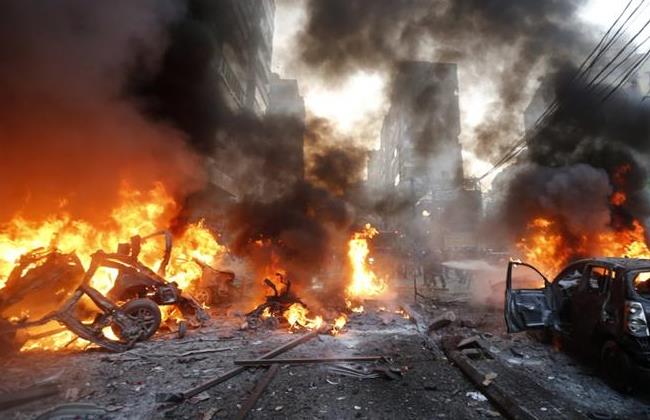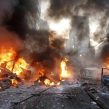
The Evolution of Sunni Jihadism in Lebanon Since 2011
Publication: Terrorism Monitor Volume: 13 Issue: 21
By:

Since the Syrian civil war began in early 2011, the conflict has reignited sectarian tensions in neighboring Lebanon, transforming parts of the country into flashpoints of violence and operational spaces for militant groups. Throughout the 1980s and 1990s, Sunni jihadists, as well as a variety of secular militants, recruited, trained and plotted in Lebanon’s Palestinian refugee camps, using them as a springboard for attacks elsewhere in the region. However, this changed when Sunni jihadist group Fatah al-Islam (FI) attempted to turn north Lebanon—which includes various impoverished, Salafist-influenced Sunni-majority areas where hatred of the Syrian regime has been brewing for decades—into a so-called Islamic emirate in 2007. Despite its defeat at the hands of the Lebanese Armed Forces (LAF) in a 111-day battle at the Nahr al-Bared Palestinian camp near Tripoli that summer, FI’s actions marked the point when Lebanon became a battleground for jihadists, rather than simply a launching pad for attacks elsewhere. This set a precedent for subsequent Sunni jihadist groups, such as Jabhat al-Nusra (JN), the Islamic State, and Abdullah Azzam Brigades (AAB), to threaten Lebanon’s territorial integrity and delicate sectarian balance.
According to the International Centre for the Study of Radicalisation, an estimated 900 Lebanese citizens have fought or are currently fighting for Sunni militant groups in Syria and Iraq. [1] This reflects that since the summer of 2011, north Lebanon emerged not only as a vast recruiting pool, but also as an effective staging area for Lebanese jihadists crossing into Syria. Supported financially by local Salafist leaders, these jihadists fought for either FI, Jamaat Jund al-Sham (JJS) or smaller groups. FI, in particular, fought battles against the Syrian government in Aleppo, Rif Dimashq, al-Qusair and Homs. [2] However, with most of its leadership decimated by September 2012, FI’s rank-and-file subsequently merged with other groups, including JJS.
Historically a Palestinian extremist group based in Ain al-Helwah, JJS reemerged in late 2012, as a major recruiter of Lebanese Sunni militants. A key step in this process occurred on December 23, 2012, when former FI fighter Khaled Mahmoud al-Dandashi (a.k.a. Abu Sulayman al-Muhajir) declared himself the “amir” of the newly-formed JJS at the medieval fortress Krak des Chevaliers that overlooks Qalaat al-Hosn, a village near Homs. [3] Al-Dandashi thereafter leveraged familial and personal connections in both Lebanon and Syria to recruit hundreds of followers (al-Hayat, August 21, 2013). He also had agents who had served with him in FI embedded in the Salafist recruiting networks of the Sunni-majority Bab al-Tabbaneh district in Tripoli, which is the scene of frequent clashes against local Alawite Shi’a Muslims. Al-Dandashi remained at Krak des Chevaliers until his death in March 2014, prompting the return of 300 JJS fighters and their families back to north Lebanon (Daily Star [Beirut], March 22, 2014).
Throughout the first two years of the conflict, jihadists such as al-Dandashi focused primarily on using Lebanon as a transit point for recruits, cash and weapons. However, in 2013, the strategic direction of the Salafist-Jihadist community shifted away from fighting the forces of President Bashar al-Assad in Syria toward fighting Hezbollah and the Lebanese government, which they regarded as Hezbollah’s “proxy,” in Lebanon. With clearer objectives, Salafist-Jihadists began to behave more in unison, coalescing around the perception that destabilizing Lebanon directly contributes to the weakening of Hezbollah, and thus, al-Assad. Sunni jihadists sought to do this by tainting Hezbollah’s legitimacy and labeling the group as an Iranian tool.
Around this time, in 2012, Sunni firebrand Shaykh Ahmad al-Assir emerged as a popular voice for these grievances. Al-Assir first came to widespread attention in 2012 when he demanded an expansion of the state’s writ to curb Hezbollah’s authority (al-Akhbar [Beirut], March 2, 2012). His rhetoric at this time was conciliatory, rational and supportive of greater political rights for Sunnis, many of whom felt themselves economically and politically marginalized. His views grew more radical, however, when the Lebanese Armed Forces (LAF) grew increasingly hesitant to disarm Hezbollah, especially in Sidon—the site of continuous clashes between pro-Hezbollah and pro-Assir groups. The tension reached a climax in June 2013, when several al-Assir loyalists opened fire on a LAF checkpoint in Sidon, sparking an intense, two-day firefight (Daily Star [Beirut], June 24, 2013). Al-Assir fled into hiding, but was arrested by Lebanese authorities in August 2015 (Daily Star [Beirut], August 15). Even though al-Assir is a fringe character, he came to epitomize the extent to which Sunni grievances can be transformed into armed mobilization in an “open front” and semi-conventional context against the LAF and Hezbollah.
Throughout the spring of 2014, Syrian opposition groups suffered defeats in western Syria, particularly in and around al-Qusayr, Qalamoun Nabak and Yabroud. This forced the retreat of hundreds of JN and Islamic State fighters into Lebanon, and particularly into Bekaa’s Baalbek district. Prior to the rebel influx, the Sunni and Syrian-majority camp of Arsal in the Bekaa Valley had served as a gateway for the covert transport and provision of resources and reinforcements for rebels in western Syria. However, after the influx, the camp became a safe haven for militants, allowing them to recruit Syrian refugees and launch attacks on Hezbollah and LAF positions across the northern Bekaa Valley. From December 2013 to March 2014, JN conducted 11 attacks, targeting Hezbollah positions in Hermel, Brital, Nabi Shayth and Nabi Uthman with at least 27 Grad rockets and four martyrdom operations. [4] JN cooperated with the Marwan Hadid Brigades, the Gaza Strip-based wing of the Abdullah Azzam Brigades (AAB), in two of these operations. Established in 2009 as an official al-Qaeda affiliate, AAB is a decentralized network of local militant groupings active in Egypt, Jordan, Lebanon and Palestine, all of which are responsible for a number of attacks against Israeli and Western targets.
The increasing isolation of Arsal due to military pressure from Hezbollah and the LAF encouraged greater cooperation between jihadist groups. This dynamic came into full force in August when JN and AAB came to the Islamic State’s aid in fighting the LAF in response to the arrest of Ahmad Jomaa (al-Jazeera, August 8, 2014). Jomaa was the amir of Fajr al-Islam—a detachment of the Islamic Front-allied Suquor al-Sham Brigade that cooperated closely with JN in al-Qusayr—before pledging allegiance to the Islamic State (Naharnet, August 2, 2014). [5] The five-day battle resulted in nearly 60 militants and 19 Lebanese troops killed, and dozens of security personnel being captured (Daily Star [Beirut], August 12, 2014). Even though the LAF managed to enter Arsal, the camp continues to be a source for Sunni extremism.
This inter-jihadist collaboration continued and increased in late October 2014, when the LAF busted an Islamic State-affiliated cell in Asoun and arrested its leader Ahmad Mikati, sparking a series of retaliatory attacks from Islamic State and JN militants. Mikati admitted that he sought to occupy the northern villages of Bakhoun, Asoun, Sir al-Dinnieh and Bekaa Sefrin and turn them into a safe haven for jihadist militants (al-Nahar, October 27, 2014). Mikati planned to coordinate this operation with JN-affiliated militants Khaled Hoblos in Zahrieh, a neighborhood in Tripoli, and Shadi al-Mawlawi, Ousamma Mansour, Ahmad Kasha and Abu Hureira in Bab al-Tabbaneh. Mawlawi and Mansour were the alleged recruiters of suicide bombers who had attacked the mainly Shi’a Jabal Mohsen district in Tripoli (Naharnet, January 20). Over 160 militants were arrested, dozens of weapons caches discovered and several explosives-rigged vehicles dismantled. Had this plan succeeded, the regime-held Homs corridor in Syria would have been sandwiched between two Sunni jihadist-held territories.
Meanwhile, in Lebanon, from July 2013 to February 2014, with assistance from JN elements, AAB and Islamic State operatives claimed a total of six attacks in south Beirut. In one of the most significant of these, in November 2013, AAB conducted a double suicide bombing of the Iranian Embassy, killing 23 and injuring at least 160. [6] About three months later, AAB launched another double suicide bombing on the Iranian cultural center, killing at least five and wounding more than 100. [7] The Islamic State claimed responsibility for the bomb attacks on January 4, 2014, in the capital’s Haret Hreik suburb and on June 15 at the Duroy Hotel (Daily Star [Beirut], January 2, 2014). [8]
These operations represent another example of tangible teamwork between the Islamic State, AAB, JN, JJS and FI. Illustrative of the personal connections linking various jihadist group, Naim Abbas—one of the masterminds behind the Beirut attacks—befriended Abu Musab al-Zarqawi’s bodyguard in AQI, joined forces with AAB former amir Majid al-Majid in Ain al-Helwa, received training on rocket warfare from AAB’s Sirajuddin Zurayqat and spent the majority of 2013 plotting and conducting attacks at the behest of JN and the Islamic State (al-Akhbar, February 26, 2014). His two main contacts were JN’s Yabroud amir Abu Malek al-Talli and the Islamic State’s Abu Abdullah al-Iraqi. Abbas also helped an individual named Mohamad Monther al-Hassan provide explosive material to the Duroy bombers (Daily Star [Beirut], July 3, 2014). Al-Hassan’s uncle was former JJS amir al-Dandashi, who fought with FI alongside two other of al-Hassan’s uncles (NOW Lebanon, July 16, 2014). Well after most of FI’s corps integrated into JJS, on July 7, 2014, JJS pledged allegiance to the Islamic State (YouTube, July 7, 2014). On January 25, 2014, Abu Sayyaf al-Anbari, a former FI commander, released a video announcing the establishment of an Islamic State franchise in Lebanon (al-Arabiya, January 25, 2014).
After the clashes in north Lebanon in October 2014, Salafist-Jihadists suffered a number of setbacks in 2015, including the assassination of JN leader Usama Mansur Abu Umar in April, and the arrests of al-Assir in August, Islamic State recruiter Omar Ghannoum on August 25, and Ibrahim al-Atrash in September. Al-Atrash, along with JN’s Qalamoun amir Malek Abu al-Talleh, formed and armed JN units in Arsal, and also participated in the kidnapping of LAF and policemen during the August battle (Naharnet, September 16).
Conclusion
The future of Salafist-Jihadist movements in Lebanon will largely be determined by the ongoing conflict in Syria and Lebanese domestic politics. The recent Russian military intervention in Syria may diminish the burden on Hezbollah and instead allow it to consolidate and extend its defensive ring from the northeastern Lebanese border to the Homs-Damascus corridor. This prospect could spell trouble for the thousands of Sunni fighters entrenched in Lebanon’s al-Nabek and al-Zabadani districts—key staging zones for operations in eastern Lebanon. Another overlooked but key factor is Lebanon’s domestic political situation. The Lebanese government lacks a president and remains highly-fragmented, dysfunctional and incapable of building fully-functioning, impartial non-sectarian institutions. The lack of credible, moderate Sunni leadership means that some Sunnis will continue to perceive jihadist groups as the most effective defenders of the community.
While an increase in Hezbollah’s capabilities and a refocusing of the group on Lebanon may prove disastrous for jihadist groups, it may also harden Sunni militants’ resolve to adapt and survive. Secondly, the Lebanese government shows no signs of becoming significantly more capable to govern, which means that the current conditions in the country, which have allowed jihadists to gain strength and influence, will continue. Despite the government’s recent operational success against jihadist plots, the pattern of fighters coalescing into new, emerging groups continues to underline the influential role of personal connections—most of which have roots in al-Qaeda (including the former al-Qaeda in Iraq group)—in fostering inter-jihadist collaboration and resiliency, which is correspondingly difficult to disrupt. If these groups continue to centralize under fewer banners, as seems the current trend, Lebanon’s Salafist-Jihadist movements will potentially come to pose a greater threat to the country’s fragile political state and delicate sectarian balance in the coming months and years.
Patrick Hoover is a Research Associate at the Program on Extremism at the George Washington University.
Notes
2. Please see https://jihadology.net/2012/07/18/new-statement-from-fata%E1%B8%A5-al-islam-killed-thirty-of-the-soldiers-of-the-rawafi%E1%B8%8D-kufr-in-fondness-in-rural-aleppo/; https://jihadology.net/2012/07/23/new-statement-from-fata%e1%b8%a5-al-islam-about-the-ambush-of-the-army-of-the-alawi-nu%e1%b9%a3ayris-in-the-village-of-al-qas%e1%b9%adal/; https://jihadology.net/2012/07/29/new-statement-from-fata%E1%B8%A5-al-islam-pride-of-the-mujahidin-and-the-dead-of-the-martyrs/.
4. Please see https://jihadology.net/2013/12/19/new-statement-from-jabhat-al-nu%E1%B9%A3rah-in-lebanon-targeting-the-strongholds-of-%E1%B8%A5izb-irani-with-ten-grad-rockets-in-the-hermel-region-of-lebanon/; https://jihadology.net/2014/01/16/new-statement-from-jabhat-al-nu%E1%B9%A3rah-in-lebanon-martyrdom-operation-upon-the-stronghold-of-%E1%B8%A5izb-irani-in-the-hermel/; https://jihadology.net/2014/02/02/new-statement-from-the-abd-allah-azzam-brigades-raid-of-bombing-the-stronghold-of-%e1%b8%a5izb-iran-in-the-hermel/; https://jihadology.net/2014/02/01/new-statement-from-jabhat-al-nu%E1%B9%A3rah-in-lebanon-a-second-martyrdom-operation-upon-the-stronghold-of-%E1%B8%A5izb-iran-in-the-hermel/; https://jihadology.net/2014/02/19/new-statement-from-jabhat-al-nu%E1%B9%A3rah-in-lebanon-launching-five-grad-rockets-on-the-regions-of-brital-and-al-nabi-shayth/; https://jihadology.net/2014/02/22/new-statement-from-jabhat-al-nu%E1%B9%A3rah-in-lebanon-blessed-martyrdom-operation-in-the-hermel-region/; https://jihadology.net/2014/03/03/new-statement-from-jabhat-al-nu%E1%B9%A3rah-in-lebanon-launching-a-number-of-grad-rockets-upon-the-brital-region/; https://jihadology.net/2014/03/05/new-statement-from-jabhat-al-nu%E1%B9%A3rah-in-lebanon-launching-three-grad-rockets-upon-the-region-of-al-nabi-shayth/; https://jihadology.net/2014/03/08/al-awzai-foundation-for-media-production-presents-a-new-statement-from-the-abd-allah-azzam-brigades-targeting-the-hermel-region-with-six-grad-rockets-in-conjunction-with/; https://jihadology.net/2014/03/13/new-statement-from-jabhat-al-nu%E1%B9%A3rah-in-lebanon-launching-three-grad-rockets-upon-the-region-of-al-nabi-shayth-2/; https://jihadology.net/2014/03/16/new-statement-from-jabhat-al-nu%E1%B9%A3rah-in-lebanon-blessed-martyrdom-operation-on-the-stronghold-of-the-dreaded-%E1%B8%A5izb-iran-in-the-region-of-al-nabi-uthman/.
5. The video, which has since been taken down, was available here: https://www.youtube.com/watch?v=tQB-pJEBOOg.
8. Please see https://jihadology.net/2014/06/26/new-statement-from-the-islamic-state-of-iraq-and-al-sham-the-first-raid-in-lebanon/.





